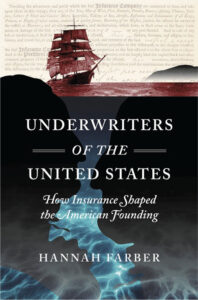 Underwriters of the United States: How Insurance Shaped the American Founding
Underwriters of the United States: How Insurance Shaped the American Founding
By Hannah Farber, Omohundro Institute and University of North Carolina Press, 2021, 352 pp, $34.95
It may be the most exciting insurance policy ever written. For a merchant ship’s voyage from Boston to the Caribbean in 1800, this sample policy covers dangers including, “The seas, men of war, fire, enemies, pirates, rovers, assailing thieves, jettisons, letters of mart and counter-mart, surprisals, takings at sea, arrests, restraints, and detainments of all kings, princes or people.”
It may be hard to believe that these dramatic words belong to a standard business transaction, but that’s the reality of the maritime world of shipping that Hannah Farber explores in her new book, Underwriters of the United States: How Insurance Shaped the American Founding. Farber, a historian who teaches at Columbia University, specializes in the economy of colonial North America. Although the exciting sample policy is simply boilerplate, Farber’s archival research is showcased throughout the book in copies of historical documents, handwritten insurance policies, artwork and newspaper columns.
“I’m very much an academic,” says Farber, “and I came to this project not from any background in the insurance industry. I just found it was fascinating.” While researching the book, she says, “I was at first just astonished by the number of references to insurance that appeared in the paperwork of people who were going on these swashbuckling adventures … I was interested in maritime stuff because it seemed so dramatic. During the Napoleonic Wars, there were so many captures, there was smuggling, there were privateers, there was naughty merchant behavior happening all over the place.”
For sheer drama, this in-depth look at how American shipping was insured from Colonial times to 1860 seems to offer more musical potential than the story of how Alexander Hamilton fought to found a national bank. The action encompasses the American Revolution, the French Revolutionary Wars, the Napoleonic Wars and the War of 1812, a tumultuous period when fortunes were easily made at sea and just as easily lost. And standing behind these risky and sometimes illegal adventures? The insurance policies that made them possible. Farber writes that marine insurance in this period was “an unusual business, that, for a time, had an extraordinary power to shape the course of events.”
Insuring the “Wooden World”
That power came from a North American economy that existed before trains or paved roads or factories or income taxes. Farber points out that in the years just after the American Revolution, a full 90% of the federal government’s revenue came from the customs taxes on imported goods. Those goods traveled on ocean-going ships, which British and American merchants sometimes called “the wooden world.”
Fifty years of near-constant wars in Europe and North America made crossing the ocean a dangerous business. Aside from the perils of storms and spoiled cargos, merchant ships could run afoul of pirates, foreign navies, or armed ships commissioned by enemy governments, known as privateers. But these same dangers also made shipping extremely profitable. “If you sneak goods past a blockade,” says Farber, “or if you get weapons and food to a port that’s been starved by war, you can charge really exorbitant rates.”
Farber briefly traces the history of marine insurance, starting with its invention by Italian merchants in the Middle Ages who wanted to exchange goods with other cities and countries ruled by different political regimes. In the early 1770s, the venerable company Lloyd’s of London was just a group of merchants who met to do business at Lloyd’s Coffee House on Lombard Street in London.
Insurance at the time was seen as close to gambling, sometimes for good reason. Farber writes that “death bets and other ‘wager policies’ continued to be commonplace at Lloyd’s through the 1770s … whereas underwriters went to the coffeehouse to ‘bet’ that a merchant’s vessel would not sink, others went to bet (‘insure’) that the pope would shortly die, that their lottery ticket would not be a winning one, or that the chevalier d’Eon was a woman in disguise.”
Revolution: “The Policy Not Providing Against Rebels”
At the same time, the marine insurance business was taking root on North American soil, with an estimated 15 to 20 insurance brokers selling policies that would have previously been written in London. Those brokers soon had a role to play in the American Revolution. “Many of the voyages they insured were privateering ventures, which confiscated British wealth and inconvenienced and humiliated Britons by raising their own insurance rates,” Farber writes. “American underwriting … was offense as well as defense.” Underwriters based their rates on their in-depth, personal knowledge of dozens of factors, from the weather to recent events on the proposed route, the experience of the captain and the soundness of the ship.
Back in London, a broker at Lloyd’s saw the war as just another complication of doing business, writing, “The Loss of a Ship taken by the Provincials is like to make work for the Lawyers, the Underwriters declaring that they are not Pirates, and the Policy not providing against Rebels.”
But the cost of the policies told a more alarming story. In peacetime, a British merchant could insure a shipment of rum from Jamaica to Boston for about 3% of its value. In March 1776, the rate paid by contractors to the British army rose to 13%. By the summer of 1776, it hit 32% — a newsworthy event at the time. “American newspapers proudly reported when their privateers had raised insurance rates on British vessels,” Farber writes.
Shaping business and law
As Farber researched the fledgling marine insurance business in North America, she was surprised to discover how much influence it exerted over the new nation and its politics. “I gradually realized marine insurance is a giant transnational business with a huge amount of money flowing through it, and it’s organized,” says Farber. “It’s shaped in these ways that respond to politics, and that drive politics … and one way that you make money is by shaping the laws under which you run your business.”
“In spite of insurance’s wide-ranging, inevitably political activities and the profit it generated during periods of upheaval, it retained an extraordinary aptitude for convincing Americans it was boring.” —Underwriters of the United States
Insurance brokers also routinely shaped the way those involved in the shipping business behaved. During the French Revolutionary Wars, when merchant ships were at high risk of capture, many insurance policies specified that ships had to travel with a convoy, a group of other merchant ships protected by naval ships. Farber says that once at sea, waiting for the convoy “was often an issue because merchants are often trying to beat the markets, and the convoys are sometimes slow.” But if ships left the convoy, “they either ran the risk of paying a higher insurance rate, if that’s what they agreed on with their insurer, or they ran the risk of voiding their policy.”
At other times, insurance brokers didn’t want merchants to avoid risk, but to embrace it. Farber writes, “Merchants frequently solicited insurance policies on outright illegal voyages as a matter of course, and insurers frequently provided them.” Together, merchants and brokers exploited the legal gray areas of the wartime years. For example, Farber says, “Are French ships allowed to capture American ships that are carrying British goods? Or vice versa? Are they allowed to bother Americans in order to get at their enemies? The merchants can make money, but they’re taking a lot of risks, so they want to know if they can get insurance. And the insurers have some flexibility to decide how much sailing in the gray areas they’re willing to tolerate.”
Investing in a new country
The Treaty of Paris officially ended the American Revolutionary War in 1783. (In an interesting historical side note, the first copy of the treaty was brought to New York by an insurance broker named John Delafield — a testament to the crucial role insurance brokers often played in gathering information).
After the war, insurance companies shaped the American founding in a new way: by pouring capital into banks and financing the national debt. Farber writes that “the aggregated capital held by this host of marine and fire insurance companies reshaped the American financial landscape … for the earliest American insurance companies, the most appealing investment options were the stocks of state-chartered banks and American government securities, and new companies swiftly bought vast quantities of both.”
Farber argues that these investments benefited the country as a whole. The key to the system was how investors purchased shares in a chartered insurance company. Unlike today, investors didn’t purchase their shares with cash, but with government securities. The result was that in 1803, when the national debt totaled $70 million, Farber estimates that insurance companies owned most of the $10 million that was held by incorporated bodies.
Steamboats and pirates
The conclusion of the War of 1812 ended the lengthy period of wars that began with the American Revolution. But although the oceans were more peaceful, shipping was still far from safe. Newly invented steamships were navigating the Mississippi, but they were so prone to exploding that a fresh crop of marine insurance companies sprang up in New Orleans.
Pirates were also a continuing danger. Farber writes, “Napoleonic conflict had generated a cohort of sailors and privateersmen who were in the habit of taking goods from merchant vessels by force, and the end of hostilities threw many of them out of work. Some became followers of the smuggler Jean Lafitte, who, pardoned by U.S. President Andrew Jackson for his assistance against the British during the War of 1812, resumed smuggling, piracy, and privateering in the Gulf of Mexico after the war’s conclusion.”
Searching the archives
As she researched her book, Farber found a rich trove of primary source material. “A lot of the best material for this project was in historical societies in old East Coast cities, like the Massachusetts Historical Society in Boston, and the Rhode Island Historical Society in Providence,” Farber explains. “They were founded by the new American elites who came to take their place at the forefront of American port cities, and that often means rich merchants … like merchants who made their money as war contractors during the American Revolution … or the people who made a lot of money in getting these ships to these war-starved ports in the French Revolutionary Wars and the Napoleonic Wars.”
While Farber found the business documents illuminating, she notes that they’ve been overlooked in the past. “Political historians, cultural historians, have tended to write these papers off as, ‘oh, this is just business. This is just the business side of this guy’s life.’ And in books about Alexander Hamilton or Daniel Webster, who are both big insurance guys, their biographers tend to hide this stuff about their business and put it in the background. That sort of misses the way in which the business itself is intensely political.”
Farber also found evidence in archives showing that, as she writes, “the insuring of slave vessels after 1808 was not only a Southern sin.” Even though the U.S. banned the importation of enslaved people after Jan. 1, 1808, an incriminating letter from 1809 contains the detailed plans of two Northern merchants to send the schooner Esperanza to Portugal under the command of a Boston captain. There it would obtain a Portuguese flag, then sail to Africa to pick up slaves and then transport them to Havana. Farber writes, “Although it was risky for the merchants and their shipmaster to put their plans in writing, they demanded detailed updates from their captain because … they needed ‘the necessary information, that we may make insurance in this place [Boston]’.” The voyage of the Esperanza was far from an isolated incident, and according to Farber, “some American insurance corporations underwrote foreign-flagged slave voyages fairly openly through the 1810s.”
Although Farber ends her book in 1860, she sees some parallels between the insurance business she describes and the present day. She writes, “The contemporary business of reinsurance — insuring the insurers — is perhaps easier to compare to the marine insurance of the Age of Revolution … a fundamentally transnational business of enormous size whose inevitably political bets attract little public attention.”
Laurie McClellan is a freelance writer and photographer living in Arlington, Virginia.













